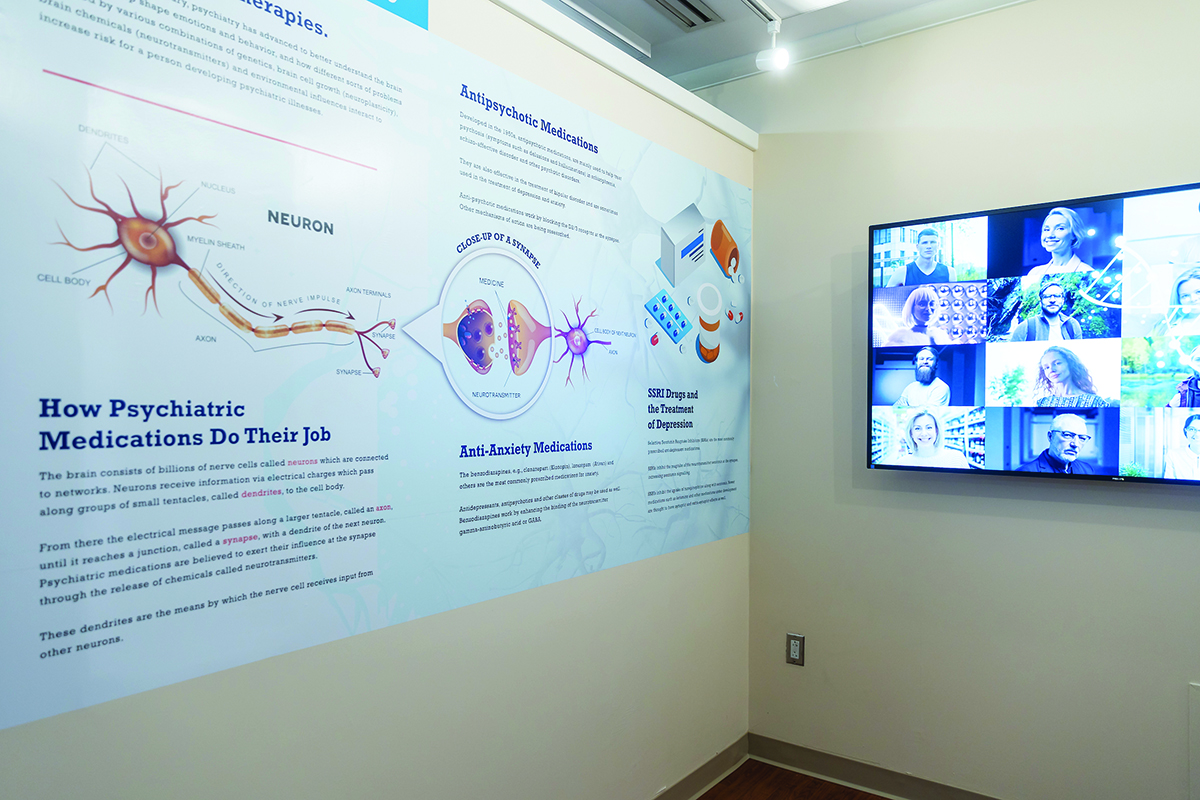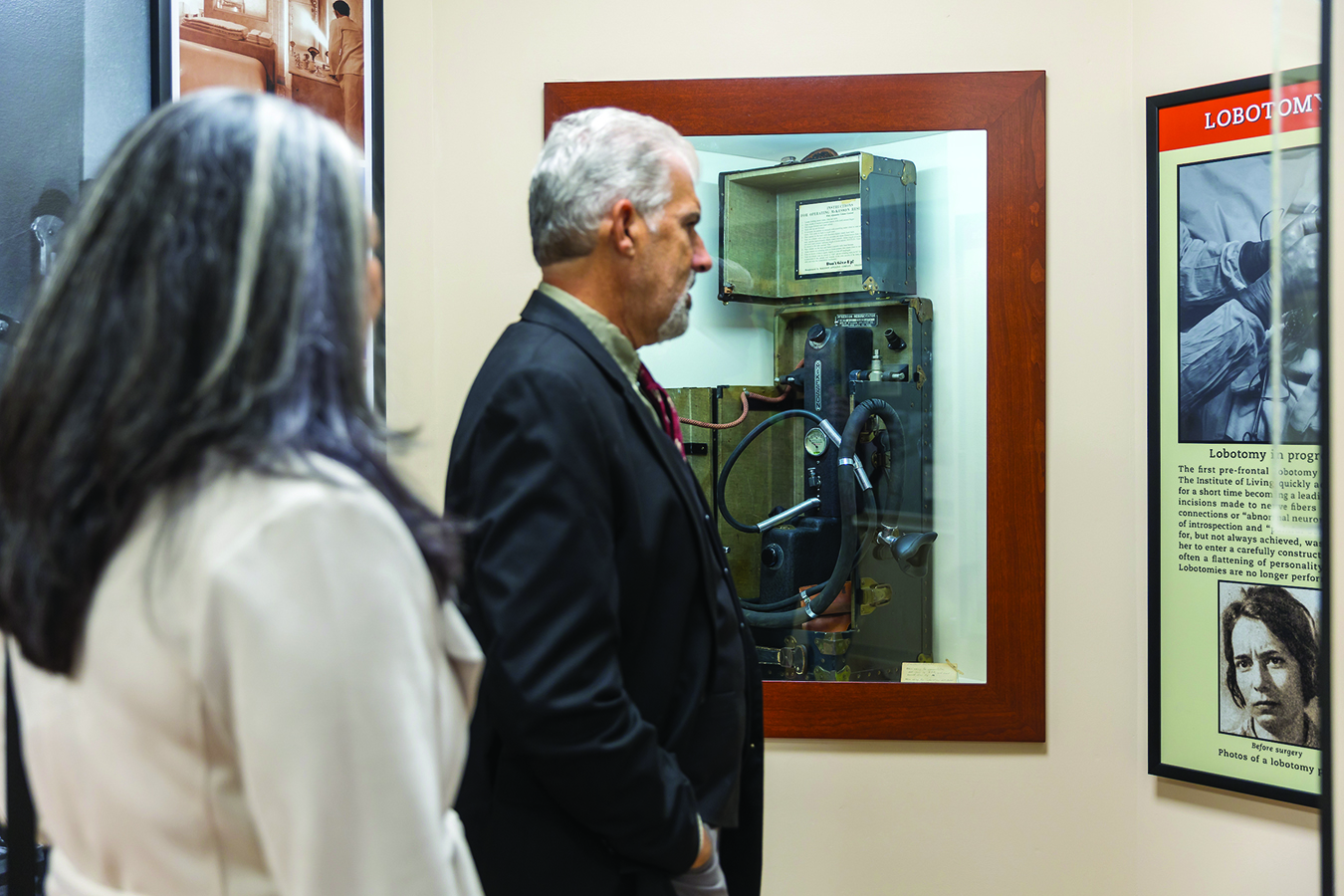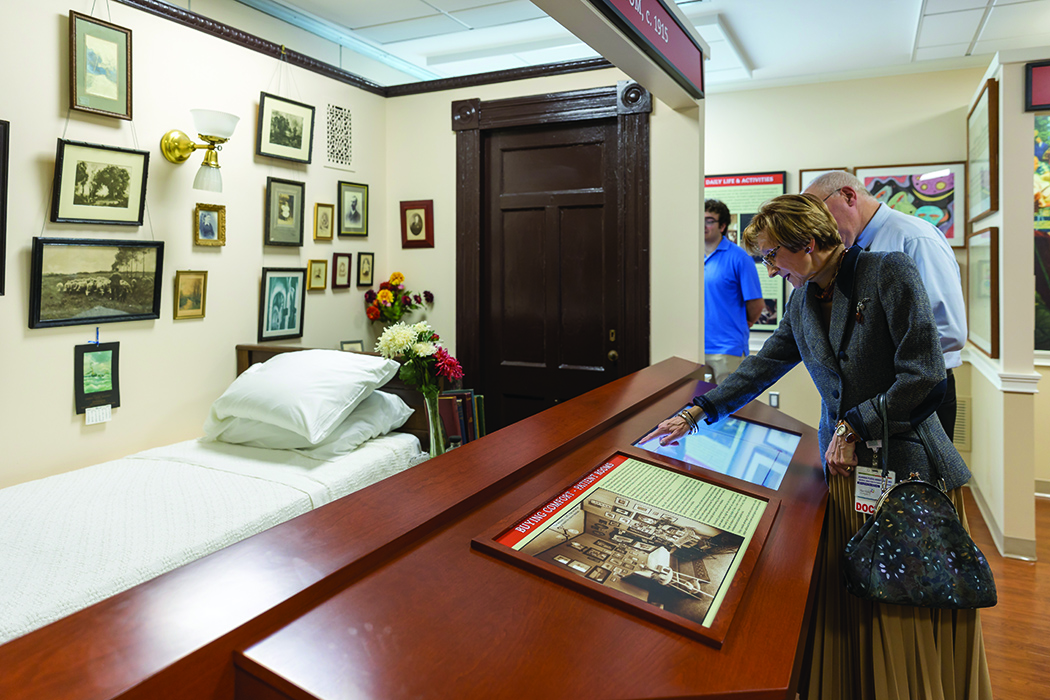New Technology Tells 200-year-old Story
By Elissa Bass
While the message about the moral treatment of people with mental illness at the Institute of Living’s museum hasn’t changed, the infusion of advanced technology has boosted the way the message is delivered to visitors.
“Myths, Minds and Medicine: Two Centuries of Mental Healthcare” first opened 28 years ago on the campus to showcase the indelible role the IOL played in the advancement of mental healthcare in this nation. Powered by a small, dedicated group and technology partners, an updated museum re-opened in the fall.
“As the IOL’s 200th anniversary came up, it seemed like a no-brainer to renovate the museum,” says Harold “Hank” Schwartz, MD, IOL physicianin-chief emeritus. “Many of the exhibits were created using the technology of the time and were in need of updating.”
The upgrade, which took several years, resulted from work by him, Harrison “Whitey” Jenkins, founder of the Connecticut Sports Museum and Hall of Fame, and Lee Monroe, Schwartz’s wife and former IOL public relations director. Jenkins was an integral part of the ideas behind and execution of new exhibits, while Dr. Schwartz and Monroe spent countless hours in IOL archives selecting items for display and updating exhibit text.
The revolutionary changes, however, came from a team from Quast Media that created new interactive exhibits.
Jeff Durham, director of strategy at Quast, notes that previous museum technology included VHS tapes and laser discs. The new exhibits tap interactive touch-screen technology to provide visitors with intriguing hands-on experiences.
“It was antiquated,” Durham says. “Audiences are constantly changing, especially in the digital age, and museums need to keep up. You need digital components to get your audience excited and engaged. We were able to use this technology to create a sense of fascination.”
A new “brain box,” for example, takes visitors digitally through different parts of the brain, with fun facts the average person wouldn’t know. There’s even a quiz to test how well you paid attention.
Tracing the history
A permanent exhibit, “Myths, Minds and Medicine” explains dramatic changes over the past 200 years in perception of and attempts to treat people with mental illness. It takes visitors from a time when the mentally ill were chained and caged, through the principles of “Moral Treatment” on which the IOL was founded, to modern day.
Visitors are welcomed at the entrance by a quote from psychiatrist Carl Jung: “I am not what happened to me, I am what I choose to become,” followed by an IOL statement, “We are here to help you choose.”
Exhibits highlight contributions from early psychiatrists to the establishment of “moral treatment,” a revolutionary approach requiring mental disorders be treated with the best medical care available and a focus on the social, psychological and spiritual aspects of patients’ lives. Founded in America at the Hartford Retreat, now IOL, moral treatment evolved into the biopsychosocial model guiding care today.
A nearby exhibit recreates a patient room from the early 20th century. Visitors can push a button to hear Monroe give a tour. Other buttons play letters from patients to family. One video captures campus life in the 1940s and 50s, while another in the Modern Therapies Room features a demonstration by Godfrey Pearlson, PhD, director of Olin Neuropsychiatry Research Center, of modern neuroscience and its application to psychiatry.
The museum is open weekdays from 9 a.m. to 5 p.m.
Schwartz Etched into IOL History
By Elissa Bass
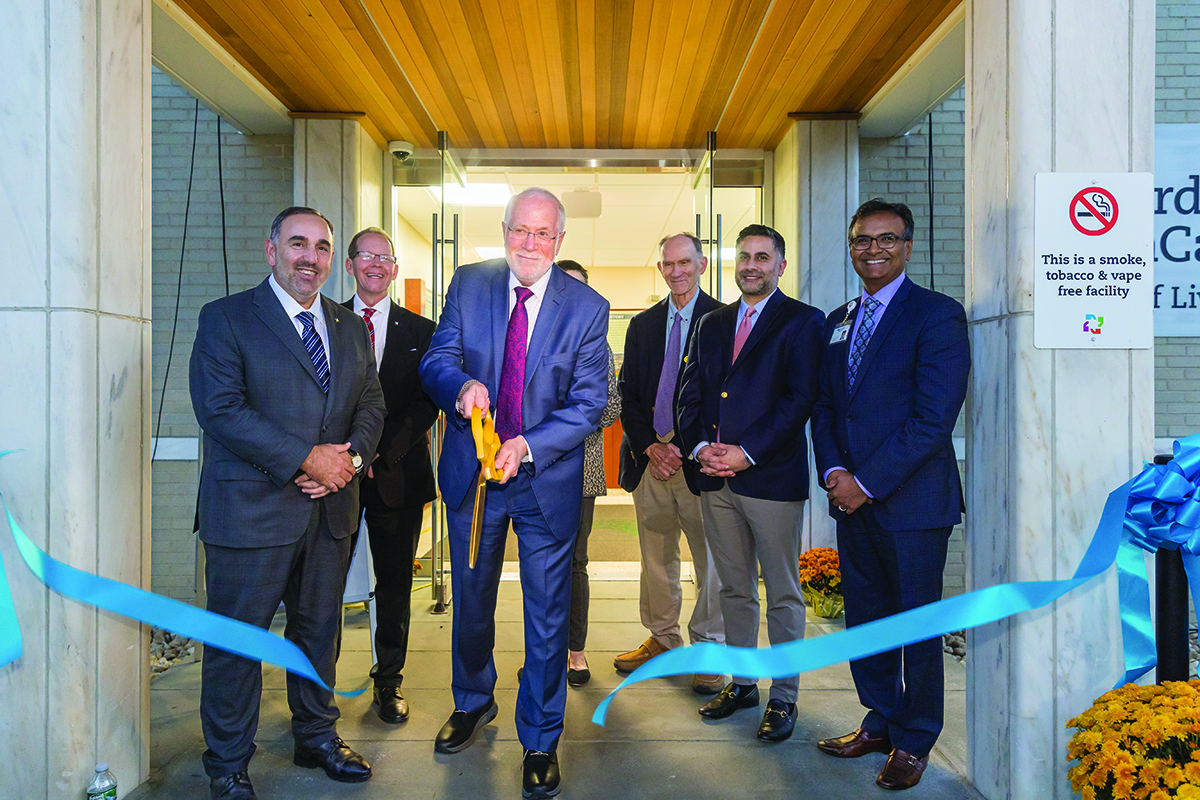
There’s a new name carved in stone at the Institute of Living, reflecting the 35-year career of Harold (Hank) Schwartz, MD.
Dr. Schwartz’s legacy includes transforming the IOL into one of the nation’s leading modern-day mental health institutions, being a voice on topics he felt were important, including speaking out against the Catholic Church during priest abuse scandals, and his work following the Sandy Hook massacre.
For this, he was honored in September with the dedication of the Schwartz Commons Building, home of the Hank Schwartz Education Center.
“It means an enormous amount to me, especially since I spent my entire professional life devoted to the IOL,” said Dr. Schwartz, who also noted the IOL has a tradition of naming buildings after people “who led the way through significant changes. I am honored to be thought worthy of that.”
“Rock star” is how John Santopietro, MD, senior vice president of Hartford HealthCare and physician-in-chief of the Behavioral Health Network, refers to Dr. Schwartz.
“It’s hard to imagine anyone having more of an impact on an organization — particularly as it relates to the dignity of the patient — than Hank has had. It’s only fitting that we honor that legacy with this building,” he said.
The achievements of Dr. Schwartz, who arrived at the IOL in 1992, shortly before merger discussions with Hartford Hospital began, include:
- Schizophrenia Initiative, a multi-faceted process that led to new programs and research such as the Olin Neuropsychiatry Research Center, home of cutting-edge research generating millions of dollars in grants.
- Potential Program helping young people showing the first signs of mental illness.
- Anxiety Disorders Center/Center for Cognitive Behavioral Therapy
- Depression Initiative
- Re-establishment of IOL residency programs for adult, child and adolescent, and psychosomatic medicine
Health Workers Bridge the Healthcare Divide
By Levell Williams
Citlaly Ibarra begins days as a certified community health worker (CCHW) at St. Vincent’s Medical Center saying good morning to her beta fish, Itzcali, whose name means “house of beauty” in the Aztec language Nahuatl.
The fish reminds Ibarra of her Mexican heritage. She moved to the United States with her family as a baby, eventually becoming the resident EnglishSpanish translator. From scheduling appointments to asking which aisle rice and beans were on in the grocery store, Ibarra played an integral role in meeting everyday needs of family and neighbors.
She’s still meeting the needs of people more comfortable speaking in Spanish, coming to SVMC to work as a CCHW, qualified bilingual colleague and certified nursing assistant. She works with Mission Services Community Health as one of three Spanish-speaking team members with Edna Borchetta, Mission Services manager, and CCHW Patricia Lopez. That skill is a huge asset as more than half of their clients speak Spanish as their first language.
As a CCHW, Ibarra typically meets clients at community health fairs and through initiatives like St. Vincent’s weekly farm stand and community health screenings and bi-weekly food distribution, where she helps connect patrons with community resources. The resources, according to Borchetta, can be essential for those suffering from food and housing insecurity, as well as other challenges.
Much CCHW work begins with informal counseling. Through multiple phone calls, texts and in-person meetings, Ibarra assesses patient needs based on their situation, then connects them with appropriate resources.
It’s work that feeds her passion to help others. For example, she and Lopez met a woman in the emergency department who’d recently emigrated from Mexico but did not speak a language they recognized. The woman was pregnant and had two young children, one of whom had an orthopedic issue with his feet and was unable to walk.
Communicating in broken Spanish and hand gestures, the CCHWs connected the mother with doctors at a local federally-qualified health center for prenatal care and pediatric care for her children. The two also connected the mother to St. Vincent’s, where she delivered her baby. Just a few days later, her son received life-changing surgery to repair bilateral club feet, a diagnosis and intervention possible through HHC’s partnership with Connecticut Children’s Medical Center.
Thanks to the work of Ibarra and Lopez, today the boy can walk and all family members have medical homes. Their efforts earned the pair a Great Catch award for spotting and addressing a preventable harm.
Yet, Ibarra says the real value is “when you can see the difference you’ve made in somebody’s life.”
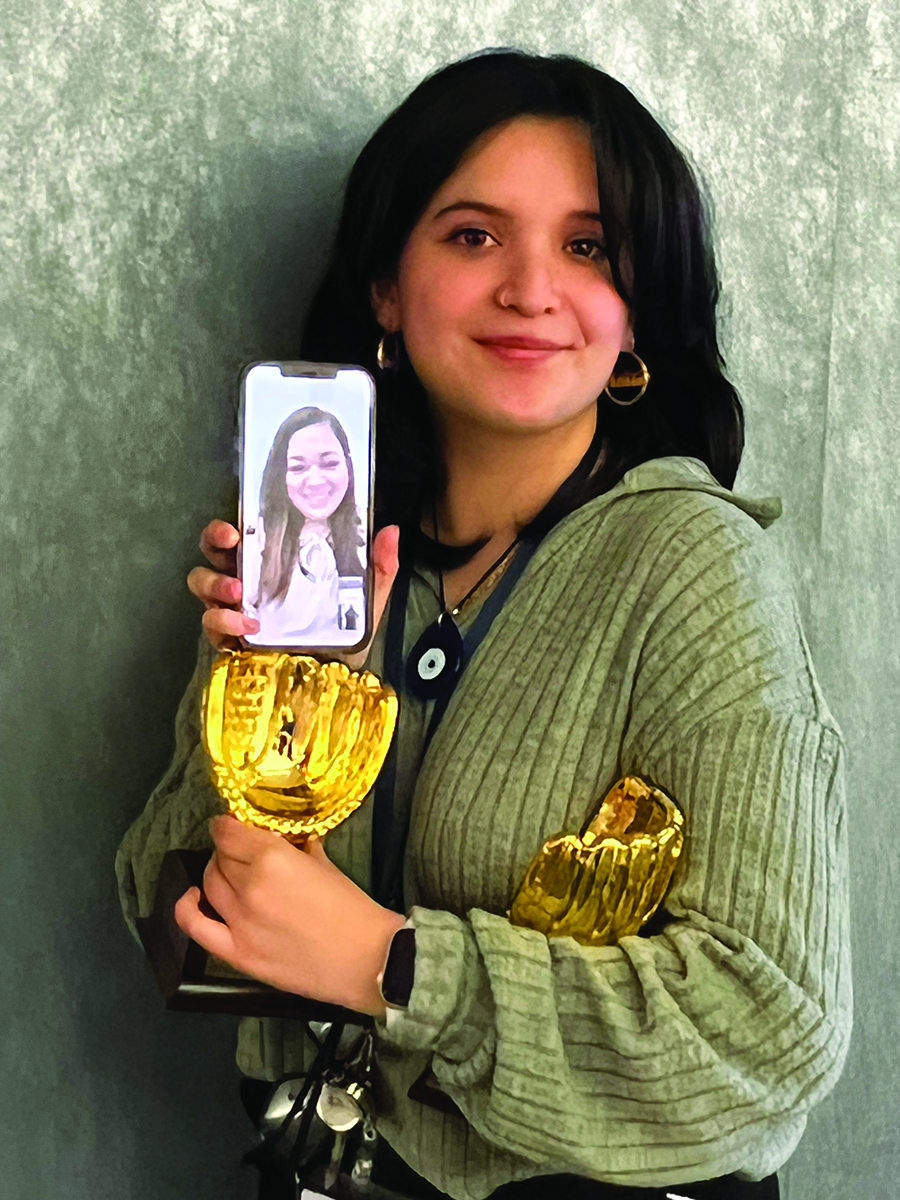
Sophia Myles Can’t Help but Help
By Elissa Bass
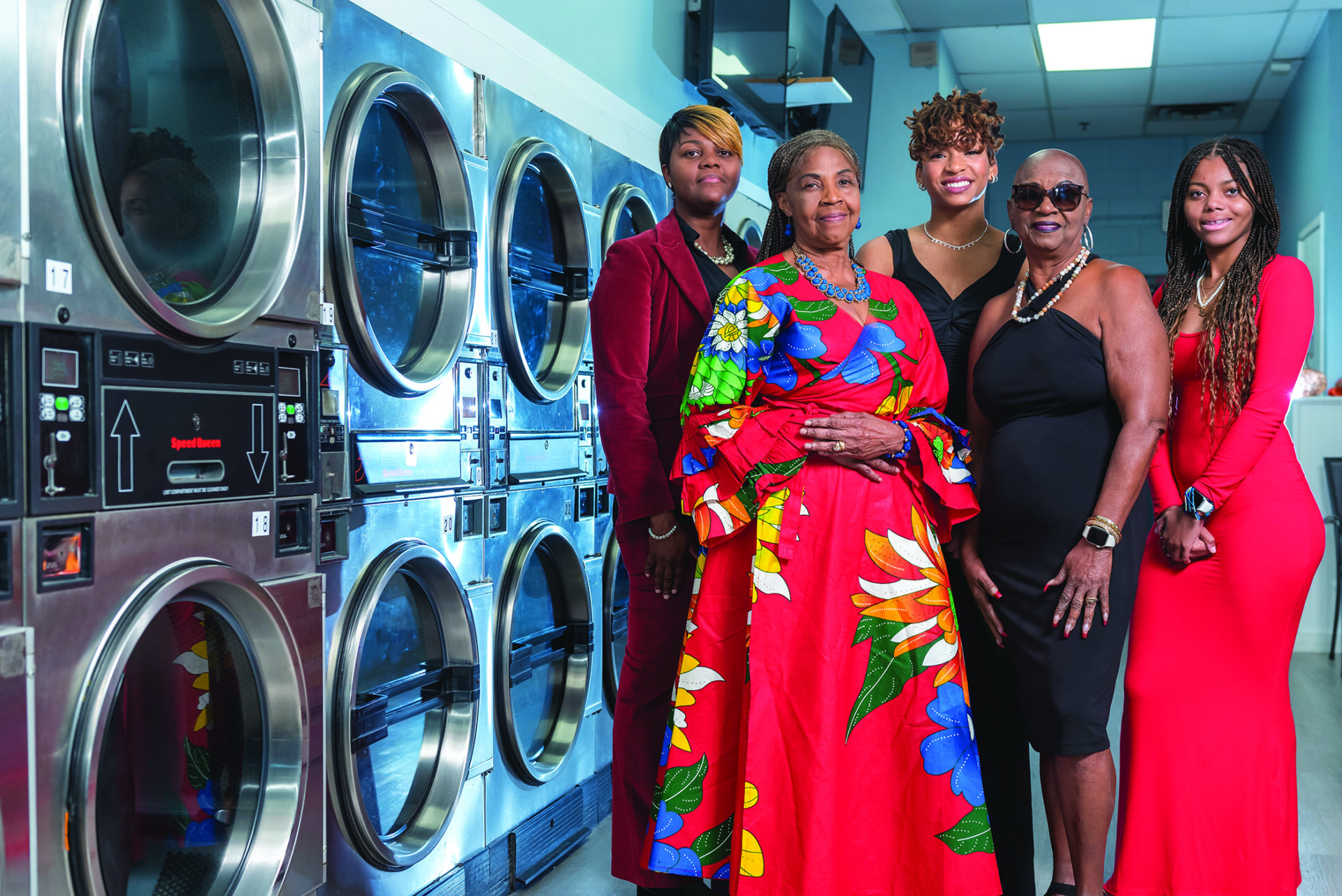
Whether it’s at her job as assistant director of environmental services at Hartford Hospital or at her family business, if there’s a problem, Sophia Myles wants to help fix it.
The same is true when she sees homeless people without access to clean or adequate clothes. To help, she enlisted her family and their business, The Laundry Room of Cromwell.
“We have been in business for a long time and we are part of the community. We wanted to find a way to give back,” Myles says. She and her brothers were brainstorming when they came up with an idea that’s a win for the business and the homeless community.
They call it “Washing Away Homelessness.”
At The Laundry Room, clothing that is not picked up by customers after 60 days is considered unclaimed. A surprising number of people drop off their clothes to be washed, dried and folded and then never return, Myles says. Things pile up.
She reached out to Hartford Hospital’s Neighborhood Health Department, which brings health prevention services and support directly into the community through mobile CareVans that visit and operate daytime health clinics every week.
CareVan staff see patients daily who need clean or better clothing. The Laundry Room team bundles unclaimed clothes and van staff hand them out to patients.
“It’s everything,” Myles says, noting that distributions started in August. “Shirts, underwear, pants, socks, really nice blankets. We didn’t want to give these things to an organization that would sell them. We wanted them to go directly to people in need.”
Not having access to clean or sufficient clothing is an issue that hits home for Myles, whose mother and aunt immigrated to the United States from Jamaica.
“As immigrants, we understand what it’s like not to have things,” she says.
The Laundry Room also partners with ABC Women’s Center in Middletown, raising money to buy diapers and other necessities for clients, and organizes an adopt-a-family program at Christmas for My Sister’s Place in Hartford, which works with homeless women and families.
Experts — Plus a Service Dog! — Ease Children Through Child Abuse Investigations
By Kate Carey-Trull
They interview about 70 children a year as part of child abuse investigations and every year it seems that more frightened faces sit before them.
The mission of the Child Abuse Investigation Team of Northwest Connecticut (CAIT NW), based in Charlotte Hungerford Hospital’s Center for Youth and Families (CYF), is to find the truth without further traumatizing child victims, says Michelle Colleoni, coordinator.
The multidisciplinary team of law enforcement, victim advocates and mental health professionals reviews about 120 criminal child abuse cases a year involving sexual and/or physical abuse, sex trafficking, and exposure to violence. Referrals come from law enforcement or the Department of Children and Families.
“Our center is a neutral, child-friendly environment where they can talk about difficult things to trained professionals. We then wrap services around the child and their family. We also provide community education to increase awareness and prevention of child abuse,” says Colleoni, who coordinates the team and schedules forensic interviews, mindful to minimize the times children have to talk about the abuse.
The center, one of 10 in Connecticut accredited through the National Children’s Alliance, also provides trauma-focused therapy for children and non-offending caregivers and on-site forensic medical evaluations through Connecticut Children’s. Such services, Colleoni says, help ease stress in what can be an overwhelming system to navigate.
Team expansion
The team recently expanded its potential impact by hiring two new members — one human and one canine. Child trauma response coordinator Kevin Tieman, a retired Torrington police detective specializing in sexual assault and child abuse cases, and his service dog Dani, a Portuguese water dog, help ease children through interviews. He’s the first service dog assigned to such a facility in the state.
Anxious children can visit with Dani to help them relax and many spend time with him before or after the interview, during therapy sessions, forensic medical exams and family meetings.
Raising awareness
Part of Tieman’s role is to serve as liaison with community agencies, such as law enforcement and the state, setting up interviews and following up on different cases. He also goes into communities to explain the investigative process to mandated reporters such as school staff, coaches and child care providers.
“We want to educate these agencies about their role as a reporter, that they need to make an immediate phone call to DCF or law enforcement, but not ask further questions of the victim at that time,” he says, adding the process helps protect the integrity of the interview and testimony for court proceedings.

ER Doc Shares the Power of Surf Therapy
By Ken Harrison
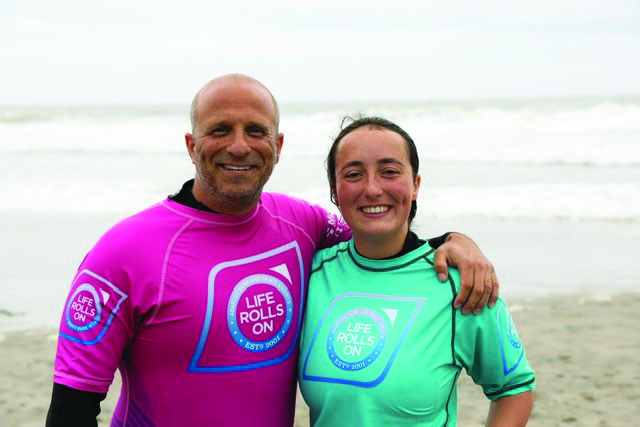
For Marc Guttman, MD, surfing offers an escape from the hectic pace of his job as a physician in the Backus Hospital Emergency Department, creating a tranquil place where he can enjoy being among waves and changing tides.
“Surfing is great outdoor exercise that gives me the opportunity to work on a fun skill,” he explains. “I started surfing during my emergency medicine training in New York City where I would take the train from Manhattan to Long Beach on Long Island. Since that time, I have enjoyed surfing waves in Central America, Hawaii, the Caribbean and Europe.”
Dr. Guttman recently began sharing his passion with some unlikely surfers when he starting working with Life Rolls On, a non-profit organization dedicated to improving the quality of life for people living with various disabilities.
Founded by Jesse Billauer, who suffered a spinal injury while surfing and became quadriplegic, Life Rolls On has been organizing adaptive surf and skate events nationwide for 20 years. In 2022, Dr. Guttman, with the help of his daughter Tara, a senior at East Lyme High School, organized Life Rolls On’s first New England event at Narragansett Town Beach in Rhode Island.
“As an emergency physician, I often see patients and their families dealing with their disabilities,” Dr. Guttman says. “Having enjoyed surfing myself for many years and enjoying the good feelings it offers, I thought that adaptive surfing must be a great way for individuals with disabilities to be active, share in the joy and maybe help be a springboard to other endeavors that could enrich their lives.”
He credits the success of Life Rolls On New England to the hundreds of volunteers and event sponsors who help make it happen, including Gnome Surf, a surf therapy organization in Little Compton, RI, which provided essential equipment and expertise.
“We had a great inaugural event last year and an even better turnout this year with surfers from Connecticut, Massachusetts and Rhode Island,” Dr. Guttman says. “We have an amazing group of volunteers, sponsors and supporters who make this an incredible event for the participants.”
Plane Pull with a Purpose
By Brian Spyros
Colleagues from the Central Region took part in a Plane Pull this fall at Tweed-New Haven Airport as part of a fundraiser for Special Olympics Connecticut. They raised $3,000 and qualified to pull an Avelo Airlines Boeing 737, which weighs 87,000 pounds! Fourteen teams from across Connecticut participated.
The Central Region came in third place, pulling the plane the required 20 feet in a little more than nine seconds.


